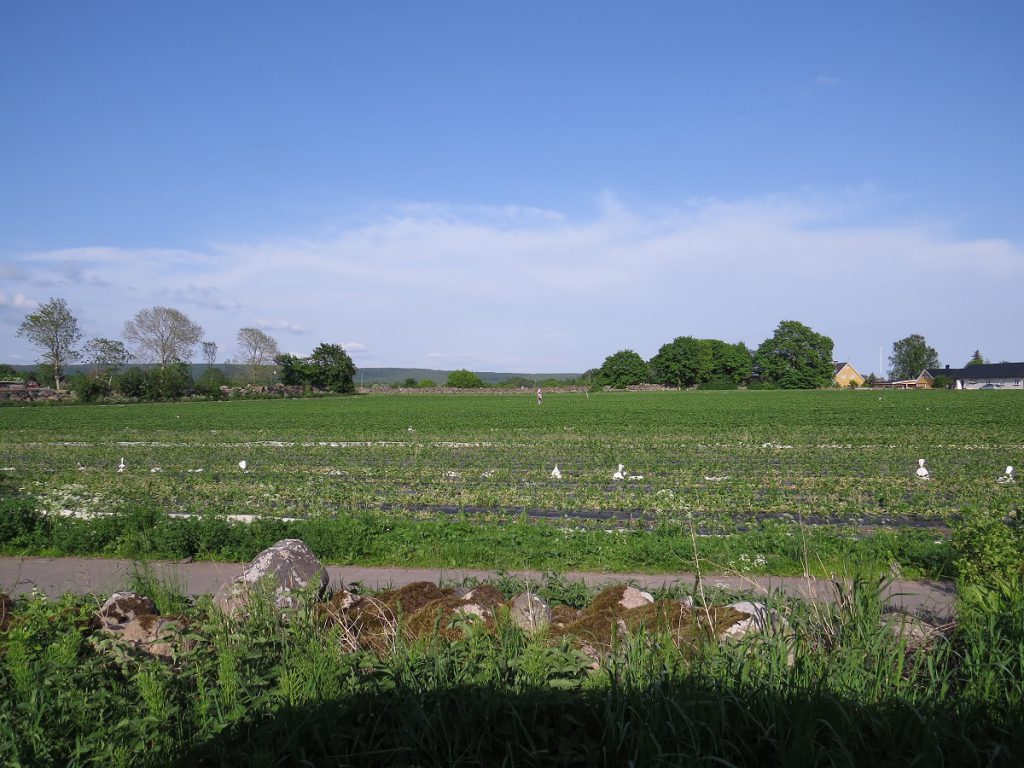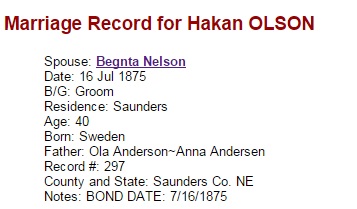I had no idea when I first started looking at this postcard that it would take me in such an amazing direction.
Last time, I told you that the person who sent the postcard was likely Eulie Olson, a first cousin of my great-grandfather P.W. “Will” Pearson. Eulie’s mother (Bengta) and Will’s mother (Johanna) were sisters.
So let’s go back to the Swedish records and see what we can learn about their family. Here is a page from the church’s Household Records for Ivetofta parish in 1850:

The head of the family is Nils Olsson and his title is “Åbo”, which means that he owns his land – but he only owns a 1/128th “mantal”. I’ll not go into what this means exactly, except to say that it’s a very small farm. The name of the farm is Grödby No. 7. (I should mention here that his last name of “Olsson” is purely coincidental with respect to Eulie.)
By the way, we drove past the Grödby farm on our trip to Sweden. Here’s a photo of the general area – it was very flat, nice-looking farmland. What looks like a person out in the field is actually a scarecrow.

Nils was married to Bertil Jönsdotter. They had a son Ola and three daughters, Elna, Bengta and Johanna. Not shown on this particular record is that there was another son, Johan, who was born in 1848 and died at the age of three months.
I followed each of the four children forward in the records.
- Ola moved around a bit, eventually married, had a daughter who married, and then he died in 1902. We might have cousins still living in Sweden, assuming that the daughter had children.
- Elna left home at the age of 18 and worked as a hired servant or farm girl on various farms in the area, sometimes returning home in between jobs. Eventually, she left for America in 1866. I have not been able to definitively locate Elna anywhere in the United States. Most likely, she married, took her husband’s surname and thus is hard to find. However, I did note a lone census entry for an Elna Nilson, age 38, living in New York City in 1880, working as a maid for a McGibney family. I have no way of knowing if this is the same person or not.
- Bengta left home in 1861, also at the age of 18 – more about her experiences below.
- Johanna left home at age 17 to work on a nearby farm, but returned home again in 1870 at age 20. She stayed there until she left for America in 1873 at age 22.
The mother, Bertil, died in 1877. Nils himself emigrated to America in 1881 with a stated destination of Omaha, Nebraska. He probably came to live with one of his daughters but I haven’t been able to verify anything about his life in America.
So let’s take a closer look at Bengta, who we now know was Eulie Olson’s mother.
Bengta left home in 1861 and worked on a nearby farm called Edenryd for two seasons. Then in 1863, she left the Ivetofta parish and moved to the neighboring parish of Sölvesborg on a farm called Ynde No. 30. She had been working there for about six years when a new farm hand appears in the record in 1869: Håkan Ericsson. Two years later, Bengta is listed as having an illegitimate child, Joel, born March 31, 1871.
On November 1, 1871, Håkan is listed as moving out and a note appears next to Bengta’s name. A friend from the Swedish Genealogical Society of Colorado helped me with the translation:
The housemaid Bengta Nilsdotter has reported Håkan Ericsson as the father of her son, Joel. So has also the housemaid Karna Svensdotter No 23 Ynde, to her son, Johan.
Uh-oh. Håkan sounds like a no-good two-timer!
The following year, Bengta and her son Joel returned back to Ivetofta. They stayed for a while at a place called Håkanryd gård..
Once empty-nested, Nils and Bertil had daughter Johanna back home for a while, but she left for America in 1873. Daughter Bengta and grandson Joel moved back home in 1874. (It’s funny how this storyline could as easily be set in 2015 as in 1874…)
Meanwhile back in Sölvesborg, two-timing Håkan and his other woman Karna are having difficulty getting married. Seems that someone has objected to the marriage! I wonder whether Bengta pulled this off on her own or if she relied upon her father for help, but in the end the parties reach a settlement. A note next to Håkan and Karna’s wedding record of November 21, 1875 states that (again from my friend at SGSC) “in order for Håkan to be able to marry he had paid off Bengta Nilsdotter 130 krona as a foster pay for an illegitimate child they had together in order for her to withdraw any claims. This deal was shown in writing and a copy of it was archived at the church.”
The payment must have been made sometime earlier that year, for on June 1, 1875, Bengta and her son Joel left Ivetofta. A register listing ticket contracts for the port city of Malmö shows the following (from left to right):
Entry Number: 50
Contract number: 1037
Purchase date: June 16
Departure date: June 16
Ticket agent: same as above
Destination: New York
Passengers: Pigan (maiden) Bengta Nilsdotter with son Joel, ages 31 and 4
From: Ifvetofta
Price: 50 krona

Exactly one month later, Bengta is in Saunders County, Nebraska and marrying Håkan Olsson (no relation to two-timing Håkan Ericsson):

It can’t be coincidence that Bengta’s sister Johanna was living in Saunders County, too. In fact, I wonder if Johanna acted as a matchmaker, given that the wedding took place so soon upon Bengta’s arrival? Perhaps Håkan Olson was a lonely bachelor neighbor and Johanna recommended her sister to him.
Digging in the homestead records, we see that Håkan had just received title to his 80-acre property on July 1.
The 1880 census shows Håkan, Bengta and Joel (now known as Eulie) living as a family, and thus we know that Eulie got his last name from his stepfather:

After all Bengta had been through, I sure hope she found happiness with Håkan.
Next time I will introduce you to Eulie’s descendants and some new-found fourth cousins!

Karen:
I found your e-mails electrifying.
Phila is a large poor city, admittedly with some wonderful assets, (art museum, huge city park, symphony etc ) and once upon a time it was a very important manufacturing town – but those days are past.
There is a part of Phila that that is insists that this decline never occured and that “old families” are still very, very important. Although I love my so- in law dearly, he comes from one of those families, and I have had to listen endlessly to stories of old families. Since Pop (Joel’s oldest son) had nothing to say about his family (because Joel was born out of wedlock?) and my recollections of meeting the Swedish part of the family are vague I have always assumed that we desended from a long line of Hillbillies, (which is partly true) and that everybody has a family of some kind, what difference does it make.
I was glad that Peggy was having a nice time with family history but frankly didn’t think much of it.
Then your e-mals arrived. I read them, decided that some day I would give them some thought, and naturally have thought about very little since.
I will send you some pictures of Joel – his fancy 1905 car, pop at 9 or so etc. In our family he was a giant. My father was an ex Marine, he was afraid of nothing – but Joel – my mother loved him and somehow his shadow fell over the family.
Once my mother said – “you are just like your Grandfather’ she could not (she and I thought ) have given me a higher compliment.
I will write you a longer note, I have lots of thoughts, but I am abut out of gas.
Your cousin
Bob Olson